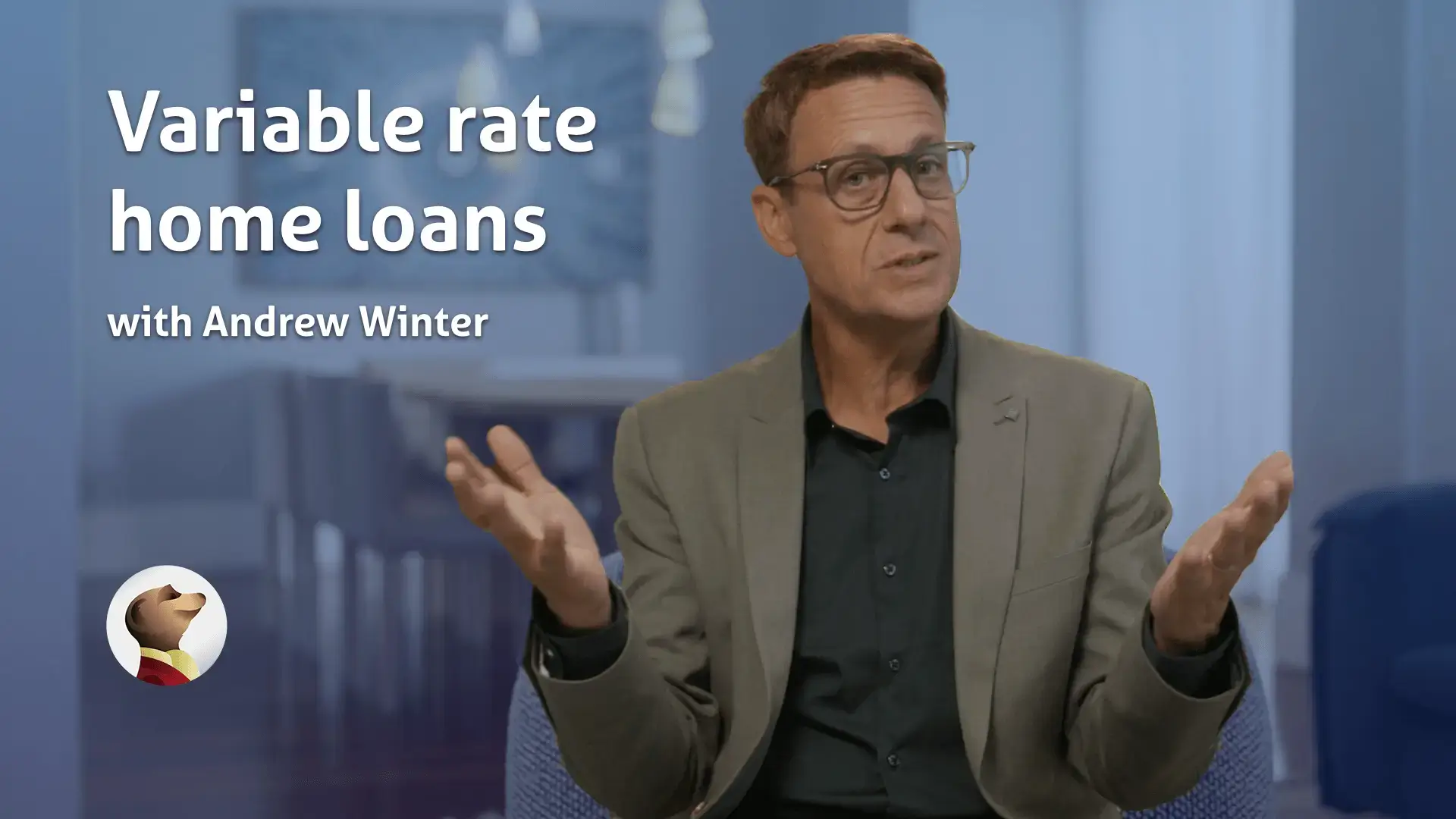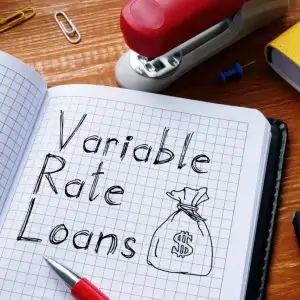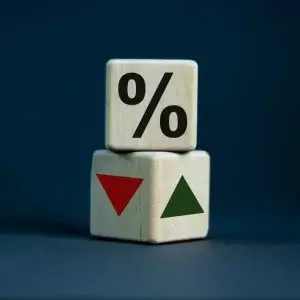Home / Home Loans / How variable rate home l…




Key takeaways
- A variable rate home loan is a type of home loan that comes with an interest rate which is not fixed, and can vary.
- Changes to variable interest rates are typically caused by cash rate decisions, but can also be solely lender-driven.
- Variable rate home loans typically give borrowers more room to make extra repayments than fixed rate home loans do.
- Borrowers on variable rate home loans are susceptible to sudden interest rate increases, which could increase their repayment amount.
What is a variable rate home loan?



Hi, I’m Andrew Winter, host of Selling Houses Australia, and I have worked with
a whole lot of homebuyers in my time. Some of them wanted stability and security,
but some of them were a bit more willing to take on risk and be flexible
when it came to their home loan. And for those type of borrowers,
I would lean towards suggesting a variable rate home loan over a fixed rate home loan.
A variable rate home loan is any home loan with a variable rate attached to it. Helpful right?
But it’s the variable rate that’s the important bit here – with a variable rate home loan,
your repayments aren’t static. That means they can fluctuate,
both up and down, based on things like the RBA cash rate (and the rate decisions
your lender makes based on the cash rate). This is a bit of a double-edged sword
if rates go up, so will the size of your home loan repayment, which nobody wants.
But if rates go down? So will your home loan repayments, freeing up more of your money for
other purposes, or for putting towards your home loan in the form of an additional repayment.
And unlike a fixed rate, which will usually have a maximum lifespan of five years, you can be on a
variable rate for just about as long as you like! Opting for a variable rate also opens up a
number of other potential features and benefits. A variable rate home loan usually means unlimited
fee-free additional home loan repayments, as well as the option to have a redraw facility
two things you won’t get with a fixed rate home loan. That being said, you might not have any use for
those sorts of things – or alternatively, you might consider them essential.
Either way, it’s important you decide what you want out of a home loan
before you start your search – not after. Once you’ve figured all those details out,
the next step is comparing your options! And Compare the Market couldn’t have made
it easier for you; their new home loan comparison tool lets you compare a wide
range of variable rate home loans from a variety of lenders around the country.
You can compare based on rates, fees, features and more, and their on-call Home Loan Specialists
can help you with any questions you might have, as well as guide you through the application process
if you’ve found the right home loan for you. So go on and get comparing!
Why choose a variable rate home loan?
- They typically allow for unlimited extra repayments towards your home loan.
- Their variable nature means you stand to benefit from an interest rate
- Variable rate home loans typically come with a wider range of optional extra features, such as offset accounts and redraw facilities.
What to know when comparing variable rate home loans
The main things to keep in mind when comparing variable rate home loans include:
- The comparison rate, which represents the total cost of the loan (including interest and upfront/ongoing fees), giving you an easy way to compare different home loans.
- The range of features on offer for each home loan. While most variable rate home loans won’t differ too much in the range of features they provide, it’s still important to check if any product you’re looking at has those perks you want in a home loan.
- Repayment flexibility, which boils down to two main questions: Can you choose your repayment frequency (weekly, fortnightly or monthly) and can you make fee-free additional repayments?
Expert tips for variable rate home loans
It’s important to understand the differences between different home loan types, and how they each might work for or against you. To help you with this, our General Manager of Money, Stephen Zeller has some tips.

Keep an eye out for cashback offers
Some lenders may offer cashback incentives for customers refinancing their loan, so when comparing variable rate options from various lenders, you may want to enquire about what cashback offers are available as well.
Review your rate regularly
You may find your variable interest rate isn’t as competitive as the years go by, and as the interest rate environment changes. It’s important to review your interest rate regularly; look to compare it with other products available in the market and ask yourself whether it could be worth exploring other lenders’ loan options.
Variable rate loans can make future sales cheaper
It’s not uncommon to be unsure about whether to get a variable rate, fixed rate or split home loan. If you’re thinking of selling your home in the future, a variable rate home loan could be an option worth considering, as there usually won’t be any break fees involved if you do repay your home loan early following the sale of your home.
Variable rate home loans explained
What is a variable rate home loan?
 A variable rate home loan is a type of home loan with an interest rate that can fluctuate up and down over the life of the loan term, rather than being locked in at a set rate for a period of time (like a fixed rate home loan).
A variable rate home loan is a type of home loan with an interest rate that can fluctuate up and down over the life of the loan term, rather than being locked in at a set rate for a period of time (like a fixed rate home loan).
Variable interest rates will usually change in response to increases and decreases in the official cash rate, which is reviewed and updated monthly by the Reserve Bank of Australia (RBA).
However, lenders have the ultimate say on the variable rates attached to their home loan products. This means that the rate for new lending on any given variable rate home loan product may not perfectly reflect the current interest rate environment and may therefore be noticeably different to the market average rate.
This could be because either the lender has implemented a rate discount, or it’s chosen not to pass on an RBA rate cut (the lender may also be planning on changing the rate in response to a recent RBA decision but hasn’t done so yet).
For borrowers on variable rate home loans, a lender’s decision to raise or lower its variable interest rates will directly affect the size of your home loan repayments; if the rate goes up, so does the size of your home loan repayments, and vice versa.
For example, if an investment property is purchased with the help of a variable rate investment loan, which currently has an interest rate of 6.50% p.a., repayments could be impacted by rate changes. If, following a cash rate cut from the RBA, a lender decides to reduce the interest rate on the variable rate home loan to 6.25% the borrower will pay 0.25% less in interest, which could save hundreds of dollars, depending on the size of the home loan.
How interest is charged on variable rate home loans
In order to understand how interest is calculated on a variable rate home loan, consider these three core loan concepts:
- Principal. This is the loan amount you borrow from a lender before any interest has been charged or accumulated.
- Interest. The interest on your home loan is calculated as a percentage of your outstanding balance based on your home loan interest rate, and subsequently added to the balance of your home loan.
- Outstanding balance. The total amount owing on your home loan, which includes the principal, any interest charged against the principal and any fees you’ve been charged.
Now, let’s discuss how they all interact within the framework of a variable rate home loan.
Lenders generally calculate interest daily, based on the outstanding balance of a variable rate home loan. This is typically done by multiplying the principal by the interest rate and dividing that figure by 365 (366 if it’s a leap year).
Depending on your lender they can take different approaches to the calculation of your repayment. In many cases the resulting figure daily figure is then multiplied by the number of days in between your regular repayments. For example, if you make fortnightly repayments, it’ll be multiplied by 14, and if you make monthly repayments, it’ll be multiplied by the number of days in the month. In other cases they can simply divide the yearly figure by 12 to obtain a monthly repayment figure.
However, given the fact that your outstanding balance is largest in the earliest years of your loan, the principal & interest payments you make early on during your home loan term will have a larger interest component than the payments you’ll make towards the end of the loan term.
You can get a more accurate idea of what you might pay over the term of your desired variable rate home loan with our mortgage repayment calculator.
Are there different types of variable rate home loans?
There are a few sub-types of home loans beyond just variable and fixed rate home loans. You can also choose how you repay your home loan by opting for either a:
- Principal and interest (P&I) loan. Making up the majority of the home loan market, P&I home loans require you to make repayments towards both the principal and interest component of your home loan. This means that each repayment you make reduces the principal of your home loan as well as covering off the interest charges you’ve accrued since your last repayment.
- Interest-only (IO) loan. An interest-only loan requires you to make just interest repayments for a set period, usually from one to five years. This typically means you’ll pay less each month to start with (as you’re not having to make repayments towards your loan principal), but your interest-only repayments aren’t actually repaying the loan itself. Once the stipulated interest-only period ends, your repayments will typically increase proportionately with the addition of a principal component.
Variable rate home loans vs fixed rate home loans
What’s the difference between fixed and variable rate home loans, and which is better for me?
When it comes to fixed rate loans versus variable rate loans and the differences between the two, there’s no objectively better option as both types of loan offer a different set of pros and cons.
Different borrowers have different financial situations, needs and priorities, which will influence their decision as to which type of home loan is right for them. For example, first home buyers and prospective owner-occupiers will have different wants and needs versus a property investor. Furthermore, different lenders will have different lending criteria and eligibility criteria.
Here are some of the main pros and cons for both variable and fixed-rate home loans:
| Variable rate home loans | |
|---|---|
| Pros | Cons |
|
|
| Fixed rate home loans | |
| Pros | Cons |
|
|
However, these pros and cons are very general; you may find a fixed rate home loan that offers the features you’re after, or you may find a variable rate home loan with lower fees relative to the rest of the market, both in terms of upfront/application fees and ongoing annual fees.
Your best bet will always be to do your own research and comparisons of real home loan products and weigh up their pros and cons. This will help you get a better idea of what’s on offer and decide which repayment type is best for you.
Can I switch from a fixed home loan to a variable rate home loan?
Most lenders will generally let you switch from a variable to a fixed rate home loan, only requiring you to fill out a form before your request can be actioned. Some lenders even let you switch home loans within their app!
However, you may incur a processing fee if switching home loans with your current lender. Additionally, if you’re switching from a fixed rate home loan, you may pay a hefty break fee for doing so.
If you’ve decided to switch to a variable rate loan from a fixed rate home loan, you should assess your options to check whether the benefits of switching loans outweigh the associated break fees and other costs. You may find that you’re better off waiting for the fixed period to end, or that switching now could save you money despite the costs. If you do decide to wait out the fixed rate period, make sure you know exactly when it ends as the standard variable rate your home loan’s set up to revert to at the end of your fixed rate period might not be as competitive as you’d like.
Can I fix a variable rate mortgage?
Your lender will typically let you convert from a variable rate home loan to a fixed rate home loan – this is known as fixing your rate. As with switching from fixed to variable, this process will typically involve lodging a request with your lender in-person, online or via your banking app.
You may pay a processing fee when switching home loans.
Important to know
How often do variable interest rates change?

Your lender can theoretically change its home loan interest rates at any point, but you may see your home loan interest rate change in the wake of the RBA’s monthly cash rate announcement.
The RBA meets eight times a year to decide on and announce any changes to the official cash rate. While this decision will usually place pressure on lenders to change their interest rates in line with the movement of the cash rate, there’s no guarantee that any given lender will definitely change their rates.
What features are available on variable rate home loans?
With the exception of products marketed as basic home loans, variable home loans tend to be a bit more flexible and feature-rich than their fixed rate counterparts, and so you’ll generally have the option to add the following features to your home loan.
Redraw facility
Making extra repayments on your home loan can help to reduce its term and save you money on interest, so it may be something worth considering. Usually, if your home loan allows you to make extra repayments, you may be able to access and redraw these extra repayments when you need them up to the loan limit.
However, it’s worth noting that:
- You can only redraw the part of your extra repayments that are in excess of your regular repayment, rather than the entire repayment.
- While making redraws won’t affect the size of your home loan repayment, you may want to minimise the number of redraws you do make, to make and retain as much progress on your home loan as possible.
Mortgage offset account
A mortgage offset account is a type of transaction account connected to your home loan account. The amount that sits in the offset account is offset against your home loan principal for the purpose of calculating interest, which will reduce the interest payable on your home loan.
For example, say you have $100,000 owing on your home loan. If you have $20,000 in a 100% offset account (meaning all the money is offset, not just a portion), your lender will only calculate and charge interest on the $80,000 difference.
It sounds like a great feature to have, but be aware that it may come with additional costs. Lenders may charge borrowers either a monthly or annual package fee, or a higher interest rate, for the privilege of having an offset account attached to their home loan.
Split facility
Some lenders will let you ‘split’ your home loan principal into two components for interest calculation: one with a variable rate and one with a fixed rate. The fixed portion will be for a fixed term (similar to interest-only home loans) with the split amounts generally chosen at your discretion. For example, you could have a 50:50 variable-fixed split, which means 50% of your home loan will have a fixed interest rate and the other half will have a variable interest rate.
Split home loans can offer a ‘best of both worlds’ solution to borrowers by allowing them to lock in a fixed rate on part of their principal, while potentially reaping the rewards of a favourable cash rate cut on the remaining portion of their principal.
However, the ‘safety’ offered by split home loans can also handicap your potential to save money on your home loan. For example, if the cash rate goes down, you’ll be paying less interest on your variable rate component, but now the rate on your fixed rate component might seem pretty steep by comparison.
Conversely, if the cash rate goes up, your fixed rate component is protected and your repayments on it will remain the same, but the repayments you’re making on the variable rate component could skyrocket. So, like with every aspect of a home loan, you should consider the pros and cons of a split loan at length before deciding whether it’s right for you.
Meet our home loans expert, Stephen Zeller
Stephen has more than 30 years of experience in the financial services industry and holds a Certificate IV in Finance and Mortgage Broking. He’s also a member of both the Australian and New Zealand Institute of Insurance and Finance (ANZIIF) and the Mortgage and Finance Association of Australia (MFAA).
Stephen leads our team of Mortgage Brokers, and reviews and contributes to Compare the Market’s banking-related content to ensure it’s as helpful and empowering as possible for our readers.



